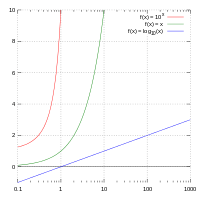Semi-log plot


In science and engineering, a semi-log graph or semi-log plot is a way of visualizing data that are related according to an exponential relationship. One axis is plotted on a logarithmic scale. This kind of plot is useful when one of the variables being plotted covers a large range of values and the other has only a restricted range – the advantage being that it can bring out features in the data that would not easily be seen if both variables had been plotted linearly.[1]
All equations of the form  form straight lines when plotted semi-logarithmically, since taking logs of both sides gives
form straight lines when plotted semi-logarithmically, since taking logs of both sides gives
This can easily be seen as a line in slope-intercept form with  as the slope and
as the slope and  as the vertical intercept. To facilitate use with logarithmic tables, one usually takes logs to base 10 or e, or sometimes base 2:
as the vertical intercept. To facilitate use with logarithmic tables, one usually takes logs to base 10 or e, or sometimes base 2:
The term log-lin is used to describe a semi-log plot with a logarithmic scale on the y-axis, and a linear scale on the x-axis. Likewise, a lin-log plot uses a logarithmic scale on the x-axis, and a linear scale on the y-axis. Note that the naming is output-input (y-x), the opposite order from (x, y).
On a semi-log plot the spacing of the scale on the y-axis (or x-axis) is proportional to the logarithm of the number, not the number itself. It is equivalent to converting the y values (or x values) to their log, and plotting the data on lin-lin scales. A log-log plot uses the logarithmic scale for both axes, and hence is not a semi-log plot.
Equations
The equation for a line with an ordinate axis logarithmically scaled would be:
The equation of a line on a plot where the abscissa axis is scaled logarithmically would be
Real-world examples
Phase diagram of water
In physics and chemistry, a plot of logarithm of pressure against temperature can be used to illustrate the various phases of a substance, as in the following for water:

2009 "swine flu" progression
While ten is the most common base, there are times when other bases are more appropriate, as in this example:

Microbial growth
In biology and biological engineering, the change in numbers of microbes due to asexual reproduction and nutrient exhaustion is commonly illustrated by a semi-log plot. Time is usually the independent axis, with the logarithm of the number or mass of bacteria or other microbe as the dependent variable. This forms a plot with four distinct phases, as shown below.

See also
- Nomograph, more complicated graphs
- Nonlinear regression#Transformation, for converting a nonlinear form to a semi-log form amenable to non-iterative calculation




